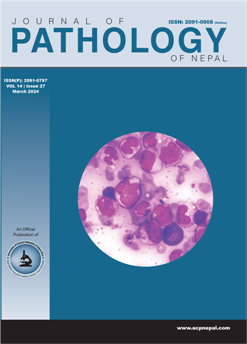Endometrial pattern in women with abnormal uterine bleeding attending a tertiary care centre of Kathmandu
DOI:
https://doi.org/10.3126/jpn.v14i1.60327Keywords:
Abnormal uterine bleeding, Endometrium, BiopsyAbstract
Background: Abnormal uterine bleeding is one of the most common problems among pre and postmenopausal women. Abnormal uterine bleeding is diagnosed when there is a substantial change in frequency, duration, or amountof bleeding during or between periodsin the absence of any organic pathology. The study was perform to assess the endometrial causes of abnormal uterine bleeding and their incidence in different age groups.
Materials and methods: It was a cross sectional and descriptive study carried out at a Manmohan medical College & hospital, over a period of two year from 13th April, 2020 to 15th March, 2022. In the study all the endometrial tissue either obtained by endometrial curettage and biopsy or hysterectomy presenting with abnormal uterine bleeding for more than 3 months were included
Results: A total of 88 cases were received during this period, out of which there were 78 endometrial tissue samples and 10 hysterectomy specimens. The patient’s age ranged from 20 years to 73years. The pattern of endometrial biopsy are Proliferative (37.5%) and secretory (20.45%) phase endometrium is the most common pattern seen, followed by disordered proliferative endometrium (13.63%), endometrial hyperplasia without atypia (9.09%), Change consistent with Exogenous Hormone (5.68%), Chronic Endometritis (5.68%), Endometrial Polyp(3.40%), Endometrial Hyperplasia with Atypia(2.27%) and Endometrial Carcinoma (2.27%).
Conclusions: Patients with abnormal uterine bleeding show a varying spectrum of endometrial pattern. Cyclic endometrium is commonly seen in the reproductive age group whereas hyperplasia and carcinomas are seen in pre/postmenopausal age group. Endometrial biopsy with histopathological examination is a major diagnostic tool in the evaluation of abnormal uterine bleeding.
Downloads
Downloads
Published
How to Cite
Issue
Section
License
Copyright (c) 2024 The Author(s)

This work is licensed under a Creative Commons Attribution 4.0 International License.
This license enables reusers to distribute, remix, adapt, and build upon the material in any medium or format, so long as attribution is given to the creator. The license allows for commercial use.




